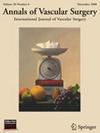Effectiveness of Incisional Negative Pressure Wound Therapy in the Prevention of Post-Amputation Complications: Systematic Review and Meta-Analysis
IF 1.6
4区 医学
Q3 PERIPHERAL VASCULAR DISEASE
引用次数: 0
Abstract
Background
Negative pressure wound therapy (NPWT) is an advanced therapy utilizing sub-atmospheric pressure at the wound site to generate a controlled environment that promotes blood flow and stabilizes the wound area. However, its effectiveness in diminishing surgical site complications remains unproven effectively. We aim to assess the impact of incisional NPWT (iNPWT) on the reduction of surgical wound complications, mortality rate, and improvement of healing rate following lower limb amputation.
Methods
An extensive search was executed in several databases for relevant studies evaluating iNPWT following lower limb amputation. We used RevMan to calculate pooled risk ratio (RR) for dichotomous outcomes and mean difference (MD) for continuous outcomes with 95% confidence interval (95% CI). The outcomes of our analysis were the assessment of overall post-intervention wound complications, surgical site infection, need for revision surgery, seroma or hematoma formation, 30-day mortality, subsequent amputation, readmission, and the time taken for complete healing.
Results
Ten studies, including a total of 1,003 patients, were included in our analysis. The findings indicate a significant reduction in the risk of overall post-intervention wound complications (RR, 0.41; 95% CI 0.20, 0.84) and a shorter time to complete healing (MD, −1.76 weeks; 95% CI −2.66, −0.86 weeks) compared to the control group. No significant difference was found in wound infection, seroma or hematoma formation, readmission, and mortality rates between the iNPWT and the control groups.
Conclusion
iNPWT significantly reduces overall post-intervention wound complications and shortens the time required for complete healing.
切口负压伤口治疗(iNPWT)预防截肢术后并发症的有效性:系统回顾和荟萃分析。
目的:负压伤口治疗(NPWT)是一种先进的治疗方法,利用伤口部位的亚大气压来产生一个可控的环境,促进血液流动并稳定伤口区域。然而,其在减少手术部位并发症方面的有效性尚未得到有效证实。我们的目的是评估iNPWT对减少手术伤口并发症、死亡率和提高下肢截肢术后愈合率的影响。方法:在多个数据库中广泛检索评估下肢截肢后iNPWT的相关研究。我们使用RevMan计算二分结局的合并风险比(RR)和连续结局的平均差异(MD),其置信区间为95% CI。我们分析的结果是评估总体干预后伤口并发症、手术部位感染、翻修手术的需要、血肿或血肿形成、30天死亡率、随后的截肢、再入院和完全愈合所需的时间。结果:我们的分析纳入了10项研究,共1003例患者。研究结果表明,与对照组相比,干预后伤口并发症的总体风险显著降低(RR, 0.41; 95% CI 0.20,0.84),完成愈合的时间更短(MD, -1.76周;95% CI -2.66, -0.86周)。在伤口感染、血肿或血肿形成、再入院率和死亡率方面,iNPWT组与对照组无显著差异。结论:切口负压创面治疗可显著减少术后创面并发症,缩短创面完全愈合时间。
本文章由计算机程序翻译,如有差异,请以英文原文为准。
求助全文
约1分钟内获得全文
求助全文
来源期刊
CiteScore
3.00
自引率
13.30%
发文量
603
审稿时长
50 days
期刊介绍:
Annals of Vascular Surgery, published eight times a year, invites original manuscripts reporting clinical and experimental work in vascular surgery for peer review. Articles may be submitted for the following sections of the journal:
Clinical Research (reports of clinical series, new drug or medical device trials)
Basic Science Research (new investigations, experimental work)
Case Reports (reports on a limited series of patients)
General Reviews (scholarly review of the existing literature on a relevant topic)
Developments in Endovascular and Endoscopic Surgery
Selected Techniques (technical maneuvers)
Historical Notes (interesting vignettes from the early days of vascular surgery)
Editorials/Correspondence

 求助内容:
求助内容: 应助结果提醒方式:
应助结果提醒方式:


